guam
 Some of the biggest defeats in any war come from underestimating the enemy or refusing to believe the facts. In the case of Japan it was a little of both. The security of the Marianas Islands, in the western Pacific, was vital to Japan, which had air bases on Saipan, Tinian, and Guam. The United States troops were already battling the Japanese on Saipan, since their arrival there on June 15, 1944. Any further intrusion would leave the Philippine Islands, and Japan itself, vulnerable to US attack. The Japanese needed to maintain their security in the Marianas Islands.
Some of the biggest defeats in any war come from underestimating the enemy or refusing to believe the facts. In the case of Japan it was a little of both. The security of the Marianas Islands, in the western Pacific, was vital to Japan, which had air bases on Saipan, Tinian, and Guam. The United States troops were already battling the Japanese on Saipan, since their arrival there on June 15, 1944. Any further intrusion would leave the Philippine Islands, and Japan itself, vulnerable to US attack. The Japanese needed to maintain their security in the Marianas Islands.
The US Fifth Fleet, commanded by Admiral Raymond Spruance, was on its way northwest from the Marshall Islands. Their mission was to provide backup for the invasion of Saipan and the rest of the Marianas. Whether he knew what was going on or not, 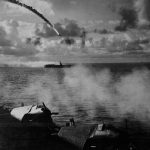 Japanese Admiral Ozawa Jisaburo, decided to challenge the American fleet. He ordered 430 of his planes, launched from aircraft carriers, to attack. The greatest carrier battle of the war was about to begin. The United States picked up the Japanese craft on radar and shot down more than 300 aircraft and sunk two Japanese aircraft carriers. By comparison, the United States only lost 29 of their own planes in the process. Strangely, Admiral Ozawa, believed that his missing planes had landed at their Guam air base. He maintained his position in the Philippine Sea, allowing for a second attack of US carrier-based fighter planes. He made his men sitting ducks!! The secondary attack, commanded by Admiral Mitscher, shot down an additional 65 Japanese planes and sink another carrier. In total, the Japanese lost 480 aircraft…about three-quarters of its total aircraft, not to mention most of its crews. American would dominate the Marianas Islands, and Japan was in deep trouble. The battle was later described as a “turkey shoot.”
Japanese Admiral Ozawa Jisaburo, decided to challenge the American fleet. He ordered 430 of his planes, launched from aircraft carriers, to attack. The greatest carrier battle of the war was about to begin. The United States picked up the Japanese craft on radar and shot down more than 300 aircraft and sunk two Japanese aircraft carriers. By comparison, the United States only lost 29 of their own planes in the process. Strangely, Admiral Ozawa, believed that his missing planes had landed at their Guam air base. He maintained his position in the Philippine Sea, allowing for a second attack of US carrier-based fighter planes. He made his men sitting ducks!! The secondary attack, commanded by Admiral Mitscher, shot down an additional 65 Japanese planes and sink another carrier. In total, the Japanese lost 480 aircraft…about three-quarters of its total aircraft, not to mention most of its crews. American would dominate the Marianas Islands, and Japan was in deep trouble. The battle was later described as a “turkey shoot.”
Not long after this battle at sea, US Marine divisions penetrated farther into the island of Saipan. Two of the 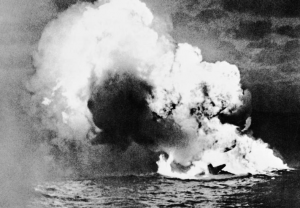 Japanese commanders on the island, Admiral Nagumo and General Saito, both committed suicide in an attempt to rally the remaining Japanese forces. I can’t imagine how that would inspire the forces. It was an act that can only be understood by a sick mind, but their plan worked. Those forces also committed a virtual suicide as they attacked the Americans’ lines, losing 26,000 men compared with 3,500 lost by the United States. Within another month, the islands of Tinian and Guam were also captured by the United States. Due to the disgrace, the Japanese government of Premier Hideki Tojo resigned at this stunning defeat, in what many have described as the turning point of the war in the Pacific.
Japanese commanders on the island, Admiral Nagumo and General Saito, both committed suicide in an attempt to rally the remaining Japanese forces. I can’t imagine how that would inspire the forces. It was an act that can only be understood by a sick mind, but their plan worked. Those forces also committed a virtual suicide as they attacked the Americans’ lines, losing 26,000 men compared with 3,500 lost by the United States. Within another month, the islands of Tinian and Guam were also captured by the United States. Due to the disgrace, the Japanese government of Premier Hideki Tojo resigned at this stunning defeat, in what many have described as the turning point of the war in the Pacific.
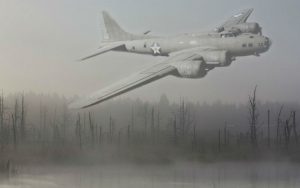
 The Swamp Ghost began its very short career on December 6, 1941, one day before the Japanese attacked Pearl Harbor. The Swamp Ghost started out as B-17 Flying Fortress, 41-2446 (which is not a tail number, and indicated that the plane was a new purchase) and under that number it was delivered to the United States Army Air Forces (USAAF). Eleven days later, the bomber departed California for Hickam Field in Pearl Harbor, Hawaii. The plane and her crew were based at Wheeler Field in Wahiawa for a very short time, and flew patrol missions for the Navy until February 1942, when the Japanese Troops invaded Rabaul on New Britain and established a base. Of course, this was a threat to the rest of New Guinea and Australia. In response to the invasion, 41-2446 was ordered to Garbutt Field, Townsville, in Queensland, Australia. Swamp Ghost’s crew included Pilot Captain Frederick C. “Fred” Eaton, Co-Pilot Captain Henry M. “Hotfoot” Harlow, Navigator 1st Lieutenant George B. Munroe Jr, Bombardier Sergeant J.J. Trelia, Flight Engineer Technical Sergeant Clarence A. LeMieux, Radio Operator/Gunner Sergeant Howard A. Sorensen, Waist Gunner Sergeant William E. Schwartz, Waist Gunner Technical Sergeant Russell Crawford, and Tail Gunner Staff Sergeant John V. Hall. The only crew change would be Sergeant Richard Oliver, who replaced Bombardier Trelia after he became ill.
The Swamp Ghost began its very short career on December 6, 1941, one day before the Japanese attacked Pearl Harbor. The Swamp Ghost started out as B-17 Flying Fortress, 41-2446 (which is not a tail number, and indicated that the plane was a new purchase) and under that number it was delivered to the United States Army Air Forces (USAAF). Eleven days later, the bomber departed California for Hickam Field in Pearl Harbor, Hawaii. The plane and her crew were based at Wheeler Field in Wahiawa for a very short time, and flew patrol missions for the Navy until February 1942, when the Japanese Troops invaded Rabaul on New Britain and established a base. Of course, this was a threat to the rest of New Guinea and Australia. In response to the invasion, 41-2446 was ordered to Garbutt Field, Townsville, in Queensland, Australia. Swamp Ghost’s crew included Pilot Captain Frederick C. “Fred” Eaton, Co-Pilot Captain Henry M. “Hotfoot” Harlow, Navigator 1st Lieutenant George B. Munroe Jr, Bombardier Sergeant J.J. Trelia, Flight Engineer Technical Sergeant Clarence A. LeMieux, Radio Operator/Gunner Sergeant Howard A. Sorensen, Waist Gunner Sergeant William E. Schwartz, Waist Gunner Technical Sergeant Russell Crawford, and Tail Gunner Staff Sergeant John V. Hall. The only crew change would be Sergeant Richard Oliver, who replaced Bombardier Trelia after he became ill.
Because of the B-17’s long flying range, the Japanese control of Wake Island and Guam, and the Vichy government’s armistice with the Nazi government, 41-2446 island hopped nearly 5,700 detour miles to get to Townsville. They didn’t want to take a chance on running into enemy fighters, if they could help it. On February 22, 1942, nine B-17Es of the 19th Bombing Group were scheduled to take off for Rabaul. Unfortunately, this mission seemed doomed from the start, as nothing would go quite as planned. Out of the nine aircraft, four had to completely abort the mission due to mechanical problems. To further complicate matters, bad weather conditions made it difficult to see up in the air for those who were able to takeoff. Finally, poor visibility separated the five remaining in flight.
I would like to say that was all the problems they ran into, but there’s more. When 41-2446 was to drop its payload, the bomb bay malfunctioned. The crew had to go around for a second pass, where they managed a clear drop over their target. The Japanese were working hard to make this mission fail too. Japanese fire was intense and a flak round managed to punch a hole through the starboard wing of 41-2556. Fortunately for the crew, the wing didn’t detonate. While the crew hoped to make it to Fort Moresby, they were low on fuel. The dog-fight, had seen to that. They would have to land in New Guinea.
Captain Fred Eaton thought he was setting down the bomber in a wheat field, however, they actually landed wheels-up in the middle of Agaiambo swamp. The only good news in this horrific failure of a mission was that the crew was unscathed, except for one with minor cuts and scrapes. Now, they still had to get out of the swamp. It took two days of hacking their way through the razor-sharp kunai grass for the men to reach dry land. They ran into some locals who were chopping wood. The locals took them, horribly bitten by mosquitos and infected with malaria, to their village. After a night of rest, they traveled downriver in canoes, where they were handed over to an Australian magistrate, and eventually arrived at Port Moresby on April 1…thirty six days after their crash. After a week in the hospital, the men returned to combat, but their plane did not. After 41-2446’s crash, Captain Fred Eaton flew 60 more missions. Whenever these missions would take him over the crash site, he would circle it and tell his new crewmembers the story of what happened. I suppose it was therapeutic to re-live the amazing escape from the Agaiambo swamp. This was where the plane’s legend was born. After Eaton returned home, 41-2446 slipped from the public eye for nearly three decades.
Then, in 1972, some Australian soldiers happened upon the crash. After spotting the wreckage from a helicopter, they landed on the aircraft’s wing and found the plane semi-submerged, and strangely intact. The machine guns were in place, and even the coffee thermoses were intact. They nicknamed the plane, Swamp Ghost, and the name stuck. Thanks to warbird collector Charles Darby who included dozens of photographs in his book, Pacific Aircraft Wrecks, word spread in 1979 . Once the fad of recovering World War II aircraft really took off. Trekkers hiked into the site and began stripping the aircraft for keepsakes and sellable items. Despite the stripping, the aircraft structure itself remained remarkably intact, until it was removed from the swamp.
Alfred Hagen, a pilot and commercial builder from Pennsylvania, set his sights on Swamp Ghost and wanted to take it free it from the disintegration of the swamp. In November 2005, he obtained an export permit for the 
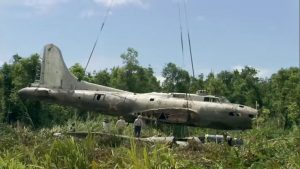 B-17 for $100,000. For four weeks they labored over the aircraft, dismantling it in order to ship it out of the country. The controversy over its removal halted the cargo before it could be shipped to the United States. Eventually, it was cleared for import and by February 2010 it arrived at the Pacific Aviation Museum at Pearl Harbor for display.
B-17 for $100,000. For four weeks they labored over the aircraft, dismantling it in order to ship it out of the country. The controversy over its removal halted the cargo before it could be shipped to the United States. Eventually, it was cleared for import and by February 2010 it arrived at the Pacific Aviation Museum at Pearl Harbor for display.
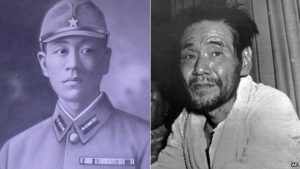 These days, lots of people have considered living off the grid. It’s almost the latest thing. Most of them really just want to do away with the bills that go along with being on the grid…water, electric, gas etc, but some of them are really wanting to lead a disconnected life. They want to shut off the phone, television, and computer, and just enjoy nature. To me, that sounds like fun for about a day…but then I am more a child of the age of technology than even my kids and grandkids are sometimes, and that’s saying something, because they are technological people, in one way or another. I have to wonder how the off the grid people would feel about it, if they had been Shoichi Yokoi.
These days, lots of people have considered living off the grid. It’s almost the latest thing. Most of them really just want to do away with the bills that go along with being on the grid…water, electric, gas etc, but some of them are really wanting to lead a disconnected life. They want to shut off the phone, television, and computer, and just enjoy nature. To me, that sounds like fun for about a day…but then I am more a child of the age of technology than even my kids and grandkids are sometimes, and that’s saying something, because they are technological people, in one way or another. I have to wonder how the off the grid people would feel about it, if they had been Shoichi Yokoi.
At this point, I’m sure that you are wondering who Shoichi Yokoi is and what was going on with him that made him such an off the grid type, so I’ll tell you. Shoichi Yokoi was a Japanese sergeant, from World War II. Shoichi was stationed on Guam, which had become a United States territory in 1898. In 1941, during World War II, the Japanese attacked Guam and captured it. The 200 square mile island, located in the western Pacific Ocean remained in Japanese Hands for three years. Then, the United States attacked and retook the island. As the Japanese forces retreated and surrendered, Yokoi made the decision not to surrender, and he went into hiding in the Jungle. He dug a tunnel, that would be his home while he was in hiding. Yokoi, who had been a tailor’s apprentice before being drafted in 1941, made clothing from the fibers of wild hibiscus plants and survived on a diet of coconuts, breadfruit, papayas, snails, eels and rats. “We Japanese soldiers were told to prefer death to the disgrace of getting captured alive.” While living in the jungle, Yokoi carved survival tools and for the next three decades waited for the return of the Japanese and his next orders…three decades!!!
Somehow, this man was so far off the grid that he had no idea what was going on in the world for almost three decades, and he assumed that World War II was still going on. He spoke to no one. He hid from anyone who might have come near him. Then, he slipped up…a good thing, as it would turn out to be. After 28 years of hiding in the jungles of Guam, local farmers discovered Shoichi Yokoi hiding in the jungle. I’m sure he was totally shocked to find out that he was the only one in the world still fighting World War II!! After he was discovered on January 24, 1972, he was finally discharged and sent home to Japan, where he was hailed as a national hero. I guess Shoichi must have grown to love Guam, because when he married, he and his new bride 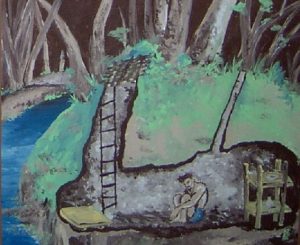
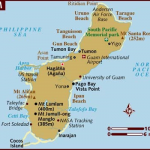 returned to Guam for their honeymoon. Shoichi went on to live a long life, and passed away on September 22, 1997 at the age of 82. The people of Guam and the governments of the United States and Japan must have though that his story was so amazing that his handcrafted survival tools and threadbare uniform are now on display in the Guam Museum in Agana. Shoichi might have been an enemy of the United States, but I can’t help but think that he must have been a very faithful soldier, to have held out that long.
returned to Guam for their honeymoon. Shoichi went on to live a long life, and passed away on September 22, 1997 at the age of 82. The people of Guam and the governments of the United States and Japan must have though that his story was so amazing that his handcrafted survival tools and threadbare uniform are now on display in the Guam Museum in Agana. Shoichi might have been an enemy of the United States, but I can’t help but think that he must have been a very faithful soldier, to have held out that long.

